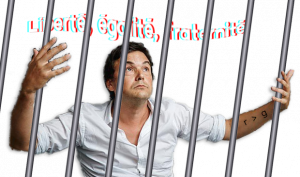The future of “rentism”
This visualization is intended to give an overview of the concept of “Rentism” as it is discussed in the writings of 5 scholars: Joseph Stiglitz, Christian Marazzi, David Harvey, Thomas Piketty and Peter Frase. The visualization is a product of a discussion we had in the “Platform Capitalism” class about the future of rentism.

The notion of rentism or rent-seeking is explained by Stiglitz as “those at the top… getting income not as a reward to creating wealth but by grabbing a larger share of the wealth that would otherwise have been produced without their effort.” (p. 92).
At the top right corner, there are images that represent the concept of the “Google model”, presented by Marazzi (p. 57). It can be identified as a new mode of producing goods and services in our age, in which corporations save costs on labor by making the consumers the testers of their products’ beta versions.
Another principle we discussed is “Gamification” (Frase, 151), in which companies make processes that harvest information entertaining in order to encourage users to complete tasks willingly and for free. This is represented by the “press start” video game button over a mundane activity: driving.
Rentism of intellectual property is represented by Two images:
-
-
- The windows pop-up “subscription to food”: This is related to the anti-Star Trek future that Frase suggests (p. 99), where everything will become encoded, therefore it will become intellectual property and something as basic as food can be licensed and leased on a subscription base
- The “Swipe right to evolve” image embodies the idea that even our own evolution will eventually become encoded and belong to someone else.
-
The concept of “Artifical scarcity”, brought forth by Frase (p. 142) is seen in four groups of images:
-
-
- The “can’t see the haters” and the “everyone’s broke but fabulous” images are related. They portray the idea that the economic elites are only preoccupied with gaining more money and focusing on making a society, while the general public is struggling to make ends meet, due to automation making wage labor almost obsolete, yet the public is still tricked into spending money continuously.
- An example of one of Frase’s job category, marketeer (p. 147) is visualized as the aggressive Bladerunner 2049 advertisement where Joi, the virtual girl, will be “everything you want to hear”.
- Last image: “____ isn’t living, this is dying”, showing the pointlessness of wage labor in the future and how it’s actually a waste of time only to keep the masses busy and have them earn money somehow, so they can spend it uselessly later.
- The glitched money represents the ephemeral nature of this artificial scarcity, showing it is just a constructed illusion.
-

An image of the economist Thomas Piketty behind bars
The image of Piketty behind bars represents how his ideas – of growing inequality due to a financial system that favors profit from accumulated wealth rather than from labor wage – will become no longer acceptable in a neo-feudalist society of gamification and artificial scarcity.
Bibliography
Stiglitz, J. E. (2012). “Rent Seeking and The Making of an Unequal Society” in The Price of Inequality: How Today’s Divided Society Endangers Our Future. New York: W. W. Norton & Company.
Marazzi, C. (2011). “Ch 3: On the Rent Becoming Profit” in The Violence of Financial Capitalism. (K. Lebedeva, Trans.). New York: Semiotext(e). pp 44-66
Harvey, D. (2005). excerpt from “Neoliberalism on Trial” in A Brief History of Neoliberalism. Oxford: Oxford University Press. pp 152-165
Piketty, T. (2014). excerpt from “Global Inequality of Wealth in the 21st Century” in Capital in the Twenty-First Century. (A. Goldhammer, Trans.). London: Belknap Press. pp 430-447
Frase, P. (2016) “Rentism: Hierarchy & Abundance” in Four Futures: Visions of the World After Capitalism London: Verso